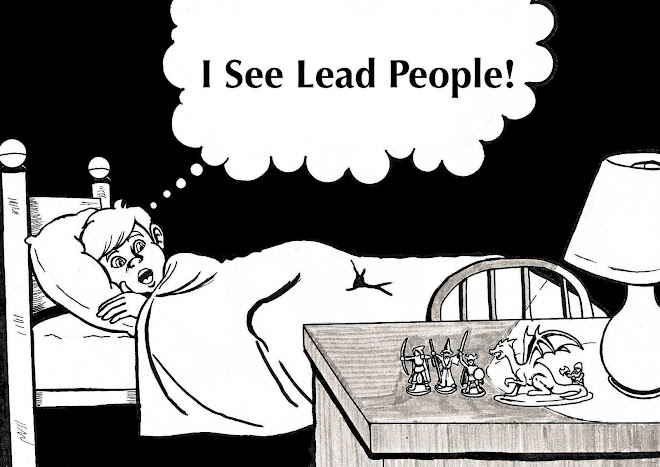Now that I have had some time to play with my new world of Elwyren, I have been able to define the specific changes to some of the ordinary races that usually haunt the classic fantasy worlds. Even though most of my new gaming group is new players or players coming back to the hobby after a long time away, I didn't think that changing up the races would be too hard on them. Besides the reskinning of the halfling, gnome and half-orc into new races, I modified humans, dwarves and elves to be a bit more unique in this setting.
Presented here are the descriptions of these races as they are in my game world, along with the specific game mechanics I have come up with for them. Some of this material is reposted from part one of my post on Elwyren races, but I've included here again to cut down on the need to flip back and forth between posts.
Human
The humans of Elwyren are the newest of the races, having only arrived in the world in the last few thousand years. The humans of this world all come from the same root culture, having divided into variations on the basic people depending on region. In most cases they can communicate on a common linguistic level even if they may not speak each other’s distinct dialect of their original language.
Humans have gained an innate magical sense when their ancestors pasted through the veil between worlds and entered Elwyren. This allows them to sense the presence of magic in an area, even if they cannot determine its exact location. With practice and experience they can refine this ability to allow them to determine the general and then later the precise location of magic.
Game Mechanics: Detect Magic 2 in 6. This ability allows them to automatically sense magic in an area but not it's specific location. It is an innate sense and will be triggered by the presence of magic items and spells or innately magical creatures within a 30' radius. The die roll is to allow them to pinpoint specific sources of magic or to filter out the magical energies of their own spells or magic items.
Elf
Elves have lived in the land of Elwyren almost as long as the beast folk and have developed a kinship with the natural forces of the land nearly as deep. The elves are a diverse people, having long adapted to a number of regions. Though they often have their own tribal or place names, they are often referred to by the type of terrain they dwell in – wood, desert, mountain, etc.
Elves have long memories and a sort of magical link to those who have preceded them. In fact, elves speak with their ancestors in a sort of memory recall that gives them a subconscious access to centuries of experience. Because of this elves often seem to have a supernatural sense of intuition as these ancient memories provide them with insight on current situations. This same long memory allows all elves to speak the same language, though local accents and minor dialects still exist.
Game Mechanics: In additional to their normal elfin abilities, the elves of Elwyren can draw upon the experience of their ancestors. This is done unconsciously and is an innate part of the elves' spiritual being. Once per encounter or event, the elf may choose to re-roll the results of a single die roll. This can be done for any roll whether or not the initial roll was a success but the elf must accept the second roll.
Dwarf
The dwarven people are a gregarious, but also stoic people with a strong sense of kinship and honor. They are robust, dwelling in areas strong in natural resources and are rather industrious beings. Valiant warriors with an indomitable will, dwarfs have long held a status as heroes of the land. Dwarves are very fond of heirlooms and traditions and it is not uncommon for a young or inexperienced dwarf to be found wielding a weapon which might seem, to others outside of dwarven society, beyond his status.
Game Mechanics: The starting primary weapon of a Elwyren dwarf adventurer is a magical weapon of +1.
Pechi (Mouselings)
One of the beast folk races left in the world, the pechi appear to be anthropomorphized mice, standing anywhere from 2-3 feet tall. They are homey and shy, but friendly. Pechi are found throughout the land in small enclaves with a very tight community structure. They live in underground burrows often finished and outfitted inside as others might do with a surface dwelling.
Game Mechanics: Pechi are treated as halflings with the additional ability of a natural ability to climb and escape snares and holds. Pechi use their natural claws, ill-suited for combat, to aid in climbing and gain a +25% bonus instead of the normal halfling penalty. The mouselings also possess a 3 in 6 chance of being able to wiggle, squirm and disjoint their bodies out of any snare, gripping trap, hold or bindings.
Hurgeons (Hedgers)
Another of the beast folk races and the second most common after the Pechi, the hurgeons are a simple, reclusive folk who can be found in wild forests or even among the hedge rows of more civilized areas. They are robust, quick-thinking and hardy and very resistant to many forms of magic and poison. Unlike pechi who tend to freely mingle with other races, hurgeons do tend to keep to value their privacy, but will mingle when needed or when visitors call.
Game Mechanics: Herbalism - hurgeons are masters of herbal medicine, healing and apothecary arts. With this the hurgeon gains the ability to brew minor, non-magical mixtures, unguents, and ointments with a 25% chance of proficiency increasing by +5% per level of experience. These mixtures take a full hour to complete per dose and may have one of the following effects -
Hafgir
Strangely similar to humans, but a race of their own, the hafgir are brawny, bristly beings standing from 6-8 ft tall with a very hard exterior. Their corded bodies ripple with raw physical power, their angular features making them look severe even though they may not be. Excessive body hair, wild head and facial hair, gives them a slightly bestial appearance, even though they are not in any way an animal hybrid. The hafgir are actually descended from an ancient race of giants. Hafgir tend to be slightly less intelligent and slower witted than other races.
Game Mechanics: Earth healing - the hafgir are able to draw on an ancient connection with their world and use it to heal their injuries. A hafgir, rooted in place with his bare feet on raw stone may heal 1d6+2 per level worth of hit points damage once per day.























































































